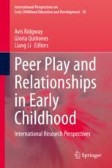Search
Search Results
-
Concept map as a tool to assess and enhance students' system thinking skills
Concept map (CM) is introduced as a useful tool for studying students’ system thinking (ST). However, it is more known to represent students’...

-
Long-Term Peer Play and Child Development
A self-evident opinion in the industrial world is that children’s pretend play promotes psychological child development. A survey of recent research...
-
Bully-victims in bullying and cyberbullying: An analysis of school-level risk factors
Considering the increasing rates of bullying in adolescence, more empirical evidence on how multiple factors work together in relation to the...

-
Improving multiple document comprehension with a lesson about multi-causal explanations in science
Relying on multiple documents to answer questions is becoming common for both academic and personal inquiry tasks. These tasks often require students...

-
Middle School Students’ Problem Solving Performance: Identifying the Factors that Influence It
This research was carried out to examine the serial mediation role of mathematics self-efficacy and metacognition for problem-solving in the effect...

-
Digital Tools in Informal Science Education Sites: A Systematic Literature Review
Informal science activities occurring at various non-traditional learning sites present a pivotal model for involving youths in the science learning...

-
The Why, Where, How and What of Curriculum Leadership: A Non-affirmative Approach
The movement from a social-democratic welfare state towards a neoliberal competition state since the 1990s in Europe required a multi-level...
-
Associations of clinical context-specific ambiguity tolerance with burnout and work engagement among Japanese physicians: a nationwide cross-sectional study
PurposeAmbiguity tolerance specific to the clinical context – in contrast to ambiguity tolerance as a personality trait – may vary with experience...

-
Methods of Causal Analysis with ILSA Data
One main aim of ILSAs (International Large Scale Assessments) is to develop an empirically based foundation of knowledge for improvement of...
-
Methods of Causal Analysis with ILSA Data
One main aim of ILSAs (International Large Scale Assessments) is to develop an empirically based foundation of knowledge for improvement of...
-
Supporting Student System Modelling Practice Through Curriculum and Technology Design
Develo** and using models to make sense of phenomena or to design solutions to problems is a key science and engineering practice. Classroom use of...

-
An experimental test of the Big-Fish-Little-Pond Effect using an immersive virtual reality classroom
Academic self-concept plays a central role in successful learning and is substantially shaped by social comparisons. Research on the so-called...

-
Toddlers’ Mathematics and Language – Two Sides of the Same Coin?
This study examines the relations between toddlers’ skills in mathematics and language and whether the relations differ for children at different...
-
Promoting learning transfer in science through a complexity approach and computational modeling
This article concerns the synergy between science learning, understanding complexity, and computational thinking (CT), and their impact on near and...

-
The Political Economy of ILSAs in Education: The Role of Knowledge Capital in Economic Growth
Economic theory suggests that the skills of a society’s population are important determinants of economic growth. ILSAs have been used to put these...
-
A feedback model applied in a ubiquitous microlearning environment using SECA rules
Understanding learners’ behavior is the key to the success of any learning process. The more we know about them, the more likely we can personalize...

-
How sensitive are the evaluations of a school’s effectiveness to the selection of covariates in the applied value-added model?
There is no final consensus regarding which covariates should be used (in addition to prior achievement) when estimating value-added (VA) scores to...

-
Apprenance: Rethinking How and Why Adults Learn
Since the dawn of the twentieth century, European educational policies have gradually stressed the necessity of lifelong learning in both civil and...
-
Constructing a Precursor Model for Clouds and Rain in the Thinking of 4–6-Year-Old Children
This study is an approach to pre-school children’s mental representations of the natural phenomena of clouds and rain. The study aims at the creation...
-
Performative Bundles: How Teaching Narratives and Academic Language Build Mental Models of Mechanisms
Science learning requires students to build new mental models of imperceptible mechanisms (photosynthesis, circadian rhythms, atmospheric pressure,...

